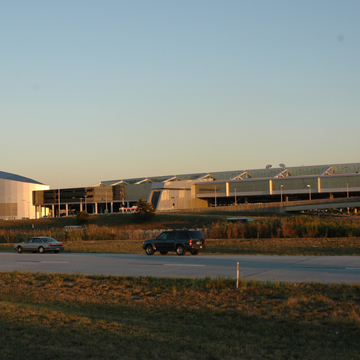The twentieth-century gateway to the city is a jumble of unrelated structures, some dating back to the 1940s, that are largely screened by Kling's Stonehengelike parking garages and Bower Lewis Thrower's minimalist Marriott Hotel. The airport was located in the marshes south of the city in the 1920s regional plan but was little more than a novelty until the arrival of economical jet travel in the 1960s. The orange-brown brick sections toward the center are remnants of Carroll, Grisdale and Van Alen's airport of the 1950s that was fronted by a small traffic circle for drop-off and pick-up with two rear canopies that sheltered passengers walking on the tarmac to airplanes. This set the great arc of the present airport, but its clarity has since been overlaid by multiple generations of buildings. In the 1990s the terminals became a retail mall with separate terminal wings. The result is moderately successful—the rocking chairs in the corridors are free and much liked—but the result offers little in the way of a grand entrance on the order of contemporary terminals, or of 30th Street Station ( PH143).
The most recent addition is the International Terminal, which is principally in Tinicum Township, Delaware County. Designed by New York City architects Kohn Pedersen Fox with local architects Kelly/Maiello, it makes an effort to create an exciting entrance with a sawtooth factorylike roof and even to celebrate flight in a giant, truncated wing form, but, being rooted in the distant industrial past, there is little relationship to contemporary life.















